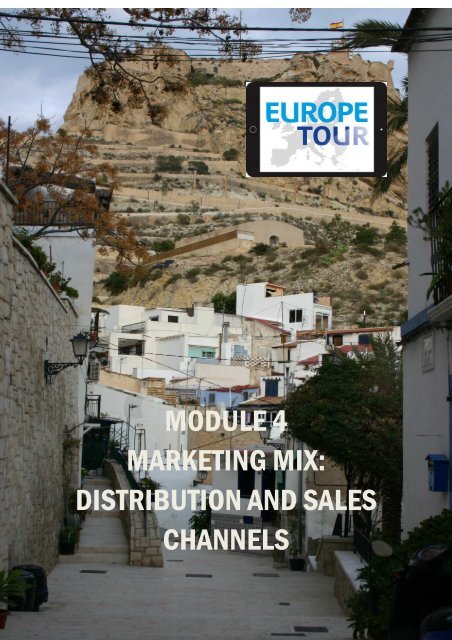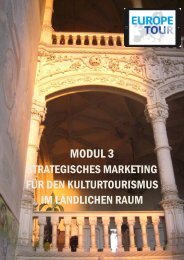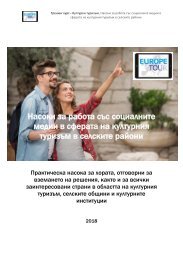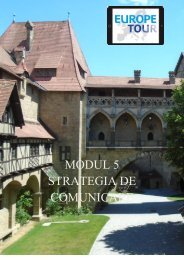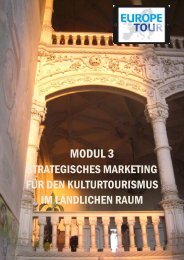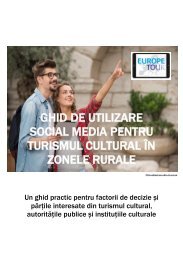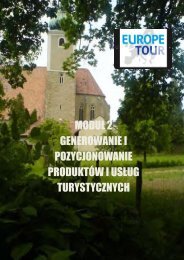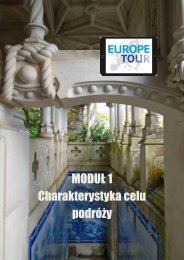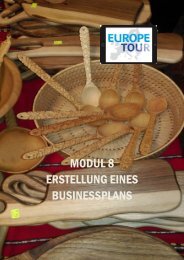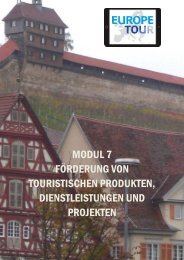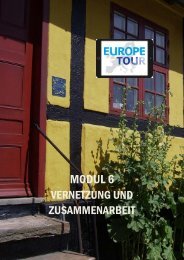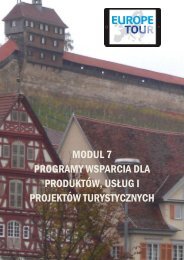Module_4_Marketing_Mix
You also want an ePaper? Increase the reach of your titles
YUMPU automatically turns print PDFs into web optimized ePapers that Google loves.
CULTURAL TOURISM TRAINING COURSE<br />
MODULE 4 - MARKETING MIX IN CULTURAL TOURISM<br />
MODULE 4<br />
MARKETING MIX:<br />
DISTRIBUTION AND SALES<br />
CHANNELS<br />
6
CULTURAL TOURISM TRAINING COURSE<br />
MODULE 4 - MARKETING MIX IN CULTURAL TOURISM<br />
This Training <strong>Module</strong> is part of the Cultural Toursim Training Course which has been developed within<br />
the Erasmus+ Strategic Partnership EUROPETOUR, a European initiative aimed at unlocking the economic<br />
potential of Europe’s outstanding cultural treasures and empowering rural areas to harvest the<br />
potential of cultural tourism.<br />
You can find more information at the homepage: http://www.europetour.tips<br />
Pictures: Wolfgang Eisenreich, Kees Grootswagers, Elena Paschinger<br />
This work is licensed under a Creative Commons Attribution-NonCommercial-ShareAlike 4.0 International<br />
License.<br />
You are free to:<br />
• share — copy and redistribute the material in any medium or format<br />
• adapt — remix, transform, and build upon the material<br />
under the following terms:<br />
• Attribution — You must give appropriate credit, provide a link to the license, and indicate if<br />
changes were made. You may do so in any reasonable manner, but not in any way that<br />
suggests the licensor endorses you or your use.<br />
• NonCommercial — You may not use the material for commercial purposes.<br />
• ShareAlike — If you remix, transform, or build upon the material, you must distribute your<br />
contributions under the same license as the original.<br />
The European Commission support for the production of this publication does not constitute an endorsement of the contents which<br />
reflects the views only of the authors, and the Commission cannot be held responsible for any use which may be made of the information<br />
contained therein.<br />
Project number: 2015-1-DE02-KA202-002325<br />
7
CULTURAL TOURISM TRAINING COURSE<br />
MODULE 4 - MARKETING MIX IN CULTURAL TOURISM<br />
Contents<br />
<strong>Marketing</strong> <strong>Mix</strong> concerns the transition from the strategic conceptual phase to the tactic operative<br />
marketing. In this module, we will explain the various marketing instruments and their mode of action.<br />
Unit 1 The 4P’s of <strong>Marketing</strong><br />
Unit 2 Product Strategies<br />
Unit 3 Pricing Strategies<br />
Unit 4 Placing Strategies<br />
Unit 5 Promotional Strategies<br />
Unit 6 The 5 th P in the <strong>Marketing</strong> <strong>Mix</strong><br />
Learning objectives<br />
After studying this module, you will understand the various types of decisions which you will need to<br />
bring your product or service to the public.<br />
You will understand what a marketing mix means for your cultural products.<br />
You will know the key features of a marketing mix.<br />
You will understand the four components of a marketing mix: product, place, price and promotion.<br />
You will understand the product benefits which are important for a successful pro-duct strategy.<br />
You will learn about pricing strategy for cultural products and services.<br />
You will be informed about various distribution strategies for your products and services.<br />
You will learn about promotional strategies and public relations.<br />
8
CULTURAL TOURISM TRAINING COURSE<br />
MODULE 4 - MARKETING MIX IN CULTURAL TOURISM<br />
Unit 1<br />
The 4 P’s in the<br />
<strong>Marketing</strong> <strong>Mix</strong><br />
9
CULTURAL TOURISM TRAINING COURSE<br />
MODULE 4 - MARKETING MIX IN CULTURAL TOURISM<br />
The 4 P’s in the <strong>Marketing</strong> <strong>Mix</strong><br />
The terminus “<strong>Marketing</strong> <strong>Mix</strong>” is a general expression used to describe the various types of decisions<br />
which you will need to bring your product or service to the public. The 4P’s is one way – presumably<br />
the best-known way – of characterizing the marketing mix.<br />
The 4Ps in the <strong>Marketing</strong> <strong>Mix</strong> are:<br />
• Product (or service)<br />
• Place<br />
• Price<br />
• Promotion<br />
Illustriaton:http://marketingmix.co.uk/4ps-in-marketing/<br />
For reasons of simplicity, this <strong>Module</strong> will use the word “product” whether it concerns tangible items,<br />
e.g. art objects or books, or intangible services, i.e. acco-modation, guided tours, concerts or similar.<br />
Basically, a marketing mix will help you understand what your cultural touristic pro-duct can offer and<br />
how to plan carefully around that. It can be executed perfectly through four elements which are the<br />
price, the place, the promotion and also the product itself.<br />
10
CULTURAL TOURISM TRAINING COURSE<br />
MODULE 4 - MARKETING MIX IN CULTURAL TOURISM<br />
In the following paragraphs, you will find a short summary of these 4 P’s.<br />
1. Product<br />
In the cultural tourism business, the “product” can either be an intangible service or a tangible good.<br />
Basically, a product should meet the visitors’ specific expectations or needs. Products usually follow a<br />
natural lifecycle and that’s why you should strive to understand and plan for each stage accordingly,<br />
identify what the product is expected to 'solve' and understand the benefits and understand the<br />
benefits as well as the features of the pro-duct itself. Once you have understood the product itself,<br />
you can follow through to identify the target visitors as well.<br />
2. Price<br />
This refers to what you expect the visitors to pay for your products or services. The pricing can have<br />
either positive or negative impact on its selling. This depends more on how your visitor perceives the<br />
value of this product than on the actual value of the product itself. Therefore, if a product has a<br />
higher or a lower price than the perceived value, it might not sell as expected. Therefore, it is<br />
important to understand what your visitor perceives before you decide to price a product. If the<br />
visitor’s perception is positive, it is likely that the product will even go for a higher price than its actual<br />
value. On the other hand, if the product has very little or no value for the visitor, it might be<br />
beneficial to underprice the product just to make some sales.<br />
3. Promotion<br />
This refers to the marketing strategies and communication techniques used to ad-vertise your product<br />
to the targeted customers. Promotion includes activities like special offers, advertising, public relations<br />
and also sales promotions. Any promo-tional channel used should always be adequate for your cultural<br />
product or service, for your visitor and also for the price. Remember, marketing is different from promotion<br />
because promotion only concerns the communication aspect of marketing.<br />
4. Placement<br />
Placement refers to how the product or service will be made available to your visi-tor. A suitable<br />
placement strategy will assess the best and most suitable distribution channel for the product.<br />
What is the purpose of the <strong>Marketing</strong> <strong>Mix</strong>?<br />
Over the years, the four elements of a marketing mix have been developed and formalized by<br />
marketing experts around the world to create and execute successful marketing strategies. This tool<br />
attempts to satisfy the supplier and the visitor con-currently. If you understand and launch it<br />
successfully, the marketing mix can con-tribute greatly to the success of your products or service.<br />
Some of the key features of marketing mix include the following:<br />
11
CULTURAL TOURISM TRAINING COURSE<br />
MODULE 4 - MARKETING MIX IN CULTURAL TOURISM<br />
• It is made up of interdependent variables that are unique. The four ele-ments of the marketing<br />
mix need to be planned together to guarantee success for any marketing strategy.<br />
• Using these elements, you can achieve any marketing targets and objec-tives such as profits,<br />
sales, or visitor satisfaction.<br />
• A marketing mix is very fluid and flexible. It’s easy to focus more or less on any of the<br />
variables depending on the current market situation.<br />
In order for the elements of a marketing mix to stay relevant and updated, moni-toring any trends and<br />
changes in your market is vital.<br />
At the head of a marketing mix strategy, there should be a qualified marketing ma-nager. This person<br />
should be able to manipulate all the variables and forces to achieve a desired result. However, cultural<br />
institutions in rural areas will hardly be able to employ or finance a qualified marketing manager.<br />
Therfore, this course gives you sufficient information in order to understand the basics.<br />
Always remember that the visitor is the most important part of any marketing mix. The overall value of<br />
the product is determined by the perceptions of the visitors. Therefore, the goal is to satisfy and retain<br />
as many visitors as possible.<br />
12
CULTURAL TOURISM TRAINING COURSE<br />
MODULE 4 - MARKETING MIX IN CULTURAL TOURISM<br />
Questions that will help you to understand the four components:<br />
Product/Service<br />
• What does the visitor need from your cultural product or service? What<br />
expectations and needs does it fulfill?<br />
• What elements does it have to address these issues?<br />
• Are there any components you have missed out?<br />
• How and where will the visitor use it?<br />
• What does it look like? By what method will visitors experience it?<br />
• What size(s), colour(s), etc. should the cultural product have?<br />
• What is it to be called?<br />
• How is it branded?<br />
• How is it differentiated from your competitors?<br />
• What is the most it can cost to provide, and still be sold adequately<br />
beneficially? (See also Price, below).<br />
Place<br />
• Where do visitors search for your item or service?<br />
• If they look in a store, what kind of store is this? A master boutique<br />
or a general store, or both? Or online? In a cata-logue?<br />
• How would you be able to get to the right distribution channels?<br />
• What do your competitors do?<br />
Price<br />
• What is the value of the item or service to the buyer?<br />
• Are there established price levels for these items or ser-vices in your<br />
area?<br />
• Is the visitor price-sensitive? Will a little decline in the price gain<br />
you additional extra market share? Or will a little increment be<br />
indiscernible, and thus give you extra profit?<br />
• What discounts should be offered?<br />
• How will your price contrast with your competitors?<br />
13
CULTURAL TOURISM TRAINING COURSE<br />
MODULE 4 - MARKETING MIX IN CULTURAL TOURISM<br />
Promotion<br />
• Where and when will you be able to get your marketing mes-sages to your<br />
target market?<br />
• Will you reach your audience by advertising online, in the press, or on TV,<br />
or radio, or on boards? By utilizing direct marketing mails? Through PR? On<br />
the Internet?<br />
• When is the best time to showcase? Is there regularity in the market? Are<br />
there any wider ecological issues that recommend or direct the timing of<br />
your market launch, or the timing of following promotions?<br />
• How do your competitors do their promotions? How can that influence your<br />
decision for promotional activities?<br />
Exercise 17<br />
<strong>Marketing</strong> <strong>Mix</strong> in your organisation<br />
Use the checklist above and describe for your organisation which marketing activities have been<br />
undertaken (or will be planned). Sort them into the four decision elements (the 4 P’s of the <strong>Marketing</strong><br />
<strong>Mix</strong>).<br />
1. Product / service<br />
________________________________________________________________________<br />
________________________________________________________________________<br />
2. Price<br />
________________________________________________________________________<br />
________________________________________________________________________<br />
3. Promotion<br />
________________________________________________________________________<br />
________________________________________________________________________<br />
4 Placement<br />
________________________________________________________________________<br />
________________________________________________________________________<br />
14
CULTURAL TOURISM TRAINING COURSE<br />
MODULE 4 - MARKETING MIX IN CULTURAL TOURISM<br />
Unit 2<br />
Product Strategies<br />
15
CULTURAL TOURISM TRAINING COURSE<br />
MODULE 4 - MARKETING MIX IN CULTURAL TOURISM<br />
Product Strategy<br />
As we explained before, a product can be a tangible thing (book, statue, liqueur, etc.) or an intangible<br />
service (concert, museum, excursion, etc.) that is offered to your visi-tor to meet his requirements or to<br />
satisfy his expectation or need. The production of this product/service costs money and it is sold to<br />
the visitor at a certain price. Also in tourism, many products follow a certain lifecycle, and if planned<br />
correctly through intelligent predictions, you will be able to adapt to the challenges that each stage of<br />
the cycle presents.<br />
For a product or a service to be successful, it has to meet and satisfy a specific need and it should<br />
be able to function as promised. The features and benefits of the product or service should be clearly<br />
communicated to your current and poten-tial customers. Another vital feature of a product is branding,<br />
because this is what differentiates itself from other similar products in the market. It also creates<br />
visitors’ recall and loyalty. These factors ultimately affect your product strategy.<br />
Product Categories<br />
There are three main categories of cultural products:<br />
• Tangible Products: These are items that can be physically touched and acquired like food,<br />
souvenir articles, clothing, books etc.<br />
• Intangible Products: These are items that may not be present physically but can still be used<br />
or felt indirectly. Examples are music or theatre perfor-mances, visits of exhibitions or<br />
museums, guided tours etc.<br />
• Services: Although most services can be considered as intangible, they are the result of an<br />
activity that is not owned by the customer.<br />
<strong>Marketing</strong> <strong>Mix</strong><br />
<strong>Marketing</strong> mix refers to determining which elements of the product are necessary for successful selling.<br />
You need to do extensive customer research in building a good marketing mix. Knowing your<br />
competitors and your target market will give you an idea on coming up with a product that appeals to<br />
customers. You must know your product strategy, as well as your pricing strategy, distribution strategy<br />
and also promotion strategy to fully develop a deep understanding and ensuring maxi-mum success.<br />
Product <strong>Mix</strong><br />
The product mix is your portfolio of cultural products and services. Within this port-folio are products<br />
that can be linked closely together to form product lines. Pro-ducts in a product line share<br />
16
CULTURAL TOURISM TRAINING COURSE<br />
MODULE 4 - MARKETING MIX IN CULTURAL TOURISM<br />
characteristics or offer similar benefits, although they are individual items that have different<br />
appearances and functions. Each item has three major factors you need to focus on – branding,<br />
packaging, and services. But first, you need to define the product’s benefits.<br />
Understanding Product Benefits<br />
Understanding benefits is a core part in a product strategy. A product’s benefit can be categorized<br />
into three levels:<br />
1. Core: This is the main benefit of the product and should be the first to be defined. For<br />
example, a souvenir in a museum’s shop can be used to cap-ture memories that will last a<br />
lifetime.<br />
2. Actual: These are benefits that differentiate the product from the competition. For the souvenir<br />
example, it could be additional benefits beyond being only a “nice item”, e.g. because it<br />
includes a practical feature, such as a timer.<br />
3. Augmented: These are the benefits that you can offer to your visitors to earn their loyalty.<br />
Examples are e.g. follow-up activities.<br />
Product Decisions<br />
Product decisions come after understanding the product mix and defining the pro-duct benefits.<br />
1. Design: You need to decide how the design will affect your product mix. Should it complement<br />
the product’s features? Or should the features be designed around it?<br />
2. Quality: Understanding the target visitors is vital for this decision. You can assign a high price<br />
to a high quality product but not every visitor may be able to afford it.<br />
3. Features: You need to come up with the final set of the product’s features. If it adds to the<br />
actual and perceived benefits, you can price it higher.<br />
4. Branding: Branding is what makes your product just a good. The brand it-self can evoke<br />
instant desires to visit your destination as it can be asso-ciated e.g. to quality and safety.<br />
17
CULTURAL TOURISM TRAINING COURSE<br />
MODULE 4 - MARKETING MIX IN CULTURAL TOURISM<br />
Exercise 18<br />
Design your product mix<br />
Design a portfolio of your cultural products and services. Try to link products (and/or services) closely<br />
together so that they form product or serivce lines.<br />
Focus on product benefits and the product decisions as described in the module.<br />
Check how close your description comes to the reality, and discuss it with friends or collaborators!<br />
________________________________________________________________________<br />
________________________________________________________________________<br />
________________________________________________________________________<br />
________________________________________________________________________<br />
________________________________________________________________________<br />
________________________________________________________________________<br />
________________________________________________________________________<br />
________________________________________________________________________<br />
________________________________________________________________________<br />
________________________________________________________________________<br />
________________________________________________________________________<br />
________________________________________________________________________<br />
.<br />
18
CULTURAL TOURISM TRAINING COURSE<br />
MODULE 4 - MARKETING MIX IN CULTURAL TOURISM<br />
Unit 3<br />
Pricing Strategies<br />
19
CULTURAL TOURISM TRAINING COURSE<br />
MODULE 4 - MARKETING MIX IN CULTURAL TOURISM<br />
Pricing Strategy<br />
Price is the amount of money that your visitors have to pay in exchange for your product or service.<br />
Determining the right price for your product can be a bit tricky. A tempting strategy for beginning a<br />
small cultural tourism businesses could be to create a bargain pricing impression by pricing your<br />
product lower than your compe-titors. Although this may boost your initial sales, a low price usually<br />
equates to low quality and this may not be what specifically culturally interested visitors should see in<br />
your product.<br />
Therefore, your pricing strategy should reflect your product’s positioning in the market and the<br />
resulting price should cover the cost per item and your profit margin. This amount should not let<br />
appear your business as timid or greedy. Low pricing hinders your business’ growth while too high<br />
pricing kicks you out of the competition.<br />
There are a number of pricing strategies that you can follow. Some strategies may call for complex<br />
computation methods and others are intuitive decisions. Select a pricing strategy that is based on the<br />
product or service itself, the competitive en-vironment, visitor demand, and other products that you<br />
offer.<br />
Cost Plus<br />
Cost Plus is taking the production cost and adding a certain profit percentage. The resulting amount<br />
will be the product’s price. You need to consider variable and fixed production costs for this pricing<br />
method.<br />
In cultural tourism, this method could be applied when you produce your own handicraft items for sale,<br />
such as embroidery. You will probably also apply this method for items that you buy and resell, e.g.<br />
books, postcards etc.<br />
Value Based<br />
Instead of using the production cost as your basis, you can consider the visitor’s perception of the<br />
product’s value. The perception of the buyer is dependent on the product’s quality, the cultural<br />
institution’s reputation, and healthfulness, aside from the cost factors.<br />
For your cultural tourism business, this method should be applied whenever pos-sible. However, it<br />
requires a careful observation of your environment.<br />
Competitive<br />
You take a survey of the pricing implemented by your competitors on a similar product that you are<br />
trying to market and then decide whether to price your pro-duct lower, the same, or higher. You<br />
should also monitor their prices and be able to respond to changes.<br />
20
CULTURAL TOURISM TRAINING COURSE<br />
MODULE 4 - MARKETING MIX IN CULTURAL TOURISM<br />
This method is generally applied, because it seems easy. However, make sure that all your costs are<br />
covered.<br />
Discount<br />
Most commonly used for old product stocks or when you’re clearing up your inven-tory. You take the<br />
advertised price and lower the amount.<br />
Apart from selling out-dated or old-fashioned articles, we do not recommend that you apply this<br />
pricing method, especially when your calculation usually follows the value based method.<br />
Psychological<br />
You may have noticed that you rarely see pricing rounded off to the nearest whole number. This is a<br />
psychological pricing strategy. € 9.99 looks more attractive than € 10.00 although you’re only saving a<br />
single cent.<br />
We recommend this pricing strategy only for mass articles where the buyer can choose between<br />
various offers. In your cultural tourism business, your reputation might become damaged if you play<br />
this game too much.<br />
Base your pricing strategy on the methods mentioned<br />
above to come up with the proper price for your touristic<br />
product or service.<br />
Remember: Price is the only P in the ‘Four Ps of<br />
<strong>Marketing</strong>’ that actually generates profit for you!<br />
The other P’s are cost factors.<br />
21
CULTURAL TOURISM TRAINING COURSE<br />
MODULE 4 - MARKETING MIX IN CULTURAL TOURISM<br />
Exercise 19<br />
Develop your pricing strategy<br />
Describe which pricing strategies have been operated (or will be planned) by your organisation.). Sort<br />
them into the various categories, and justify why you have decided on those!<br />
1. Cost plus strategy<br />
________________________________________________________________________<br />
________________________________________________________________________<br />
2. Value based strategy<br />
________________________________________________________________________<br />
________________________________________________________________________<br />
3. Competitive strategy<br />
________________________________________________________________________<br />
________________________________________________________________________<br />
4 Discount stratey<br />
________________________________________________________________________<br />
________________________________________________________________________<br />
5. Psychological stratey<br />
________________________________________________________________________<br />
________________________________________________________________________<br />
.<br />
22
CULTURAL TOURISM TRAINING COURSE<br />
MODULE 4 - MARKETING MIX IN CULTURAL TOURISM<br />
Unit 4<br />
Placing (Distribution)<br />
Strategies<br />
23
CULTURAL TOURISM TRAINING COURSE<br />
MODULE 4 - MARKETING MIX IN CULTURAL TOURISM<br />
Placing (Distribution) Strategies<br />
Place refers to distribution or to the methods and location you use that your cultural touristic<br />
products or services become easily accessible to the target cus-tomers. The type of your product or<br />
service dictates how it can be distributed.<br />
You may argue that in cultural tourism, the distribution for your products and ser-vices starts with you<br />
and ends with you because you supply them to your visitors directly, and that’s it. You may say that<br />
this is true for most touristic services, as you cannot sell a guided tour through a monastery, a<br />
museum visit or a meal in a restaurant to someone else than directly to your visitor at your place.<br />
But is this the whole truth? Couldn’t your tickets also be available on the Internet? At the reception in<br />
the hotels nearby? Couldn’t you produce a video of the tour through the monastery? Couldn’t you sell<br />
a booklet with the most famous recipes of your restaurant? In this case, you could choose among<br />
several distribution stra-tegies.<br />
Therefore, it makes sense to investigate a bit into the following paragraphs, and to reflect whether they<br />
allow you to find additional ways to sell your cultural touristic products or services!<br />
Selling Directly – There is more than one way<br />
Direct selling is certainly the most frequently used method in all cultural tourism. One advantage of<br />
selling your products and services directly is that you get a more personal feeling for the market<br />
because you interact directly with the visitors; and you can easily adapt to changes. Another<br />
advantage is that you control your product’s pricing and the methods how it should be sold.<br />
The most important distribution method for direct selling is selling on-site, but you should seriously<br />
think to include also e-commerce.<br />
Selling Through a Reseller<br />
If you want to have a wider distribution of your product, you can sell it through a third party, who will<br />
then resell your product or service. In tourism, resellers are usually travel agencies.<br />
However, there are several other possibilities especially for cultural tourism in rural areas. Imagine<br />
some of the following strategies:<br />
• Tickets for your museum are also available in the hotels and pensions in your region.<br />
• These hotels offer also selected items from your museum shop.<br />
• They are also available at the local supermarket.<br />
• The menu of your restaurant is also displayed at the museum where visitors can buy a<br />
voucher e.g. for a “medieval dinner”.<br />
• Your handicraft products are also available in the museum shop.<br />
24
CULTURAL TOURISM TRAINING COURSE<br />
MODULE 4 - MARKETING MIX IN CULTURAL TOURISM<br />
Successful business through resellers requires a dense collaboration network. In <strong>Module</strong> 5 you will read<br />
more about this.<br />
Exercise 20<br />
Distribution strategy<br />
Imagine that you suddenly would not be able to sell any product or service to your customer directly<br />
in your shop (or museum, hotel, etc..) Which indirect selling pathways could you use to maintain your<br />
business?<br />
________________________________________________________________________<br />
________________________________________________________________________<br />
________________________________________________________________________<br />
________________________________________________________________________<br />
________________________________________________________________________<br />
________________________________________________________________________<br />
________________________________________________________________________<br />
________________________________________________________________________<br />
________________________________________________________________________<br />
________________________________________________________________________<br />
Congratulations! You have saved your business! How many of these strategies do you employ already<br />
now? Can you widen them?<br />
25
CULTURAL TOURISM TRAINING COURSE<br />
MODULE 4 - MARKETING MIX IN CULTURAL TOURISM<br />
Unit 5<br />
Promotional Strategies<br />
26
CULTURAL TOURISM TRAINING COURSE<br />
MODULE 4 - MARKETING MIX IN CULTURAL TOURISM<br />
Promotional Strategy<br />
Promotion is the part of marketing where you advertise and market your product or service. It is also<br />
known as promotional strategy. Through this strategy, potential visitors get familiar with what you are<br />
selling. In order to convince them to buy your product or ser-vice, you need to explain what it is, and<br />
why they should buy it. Promoting makes your visitors feel that their needs can be satisfied by what<br />
you are offering to them!<br />
An effective promotional effort contains a clear message that is targeted to a cer-tain audience and is<br />
done through appropriate channels. The target customers are people who will use your product or<br />
service. Identifying these people is an impor-tant part of your market research. The marketing image<br />
that you are trying to con-vey to them must match with your advertisement’s message. It should catch<br />
your target visitors’ attention and either convince them to buy or at least state their opinion about the<br />
product. The promotional method you choose in order to convey your message to the target visitors<br />
may probably involve more than one marketing channel.<br />
Advertising<br />
Advertising is a key promotional strategy and can be done through the following:<br />
Print<br />
Print advertisements can be distributed via direct mail or printed media which in-clude newspapers,<br />
flyers, trade and consumer magazines. You can also send letters, contests, fact sheets, brochures, and<br />
coupons to current or potential visitors across the whole country. Print advertisements let people know<br />
what, where, when, and why they should buy your product.<br />
Electronic<br />
You will certainly advertise electronically through your website and provide impor-tant and relevant<br />
information to visitors and customers. You can also send adver-tisements via direct e-mail as part of<br />
your promotional strategy. You will find more about how to use electronic communication and<br />
especially social media in the EUROPETOUR Social Media Guidelines.<br />
Tourism and Holiday Fairs<br />
Although quite costly, you will reach your target groups, i.e. possible resellers and your potential<br />
visitors, in high numbers within a short time. Try to participate in joint exhibitions that are organised by<br />
regional or national tourist associations, or organise an exhibition stand with several other cultural<br />
tourism providers from your network.<br />
Word of Mouth<br />
They say the best advertisers are satisfied customers and the reverse can also be said. When<br />
customers like or dislike your products, they tell other people about it.<br />
27
CULTURAL TOURISM TRAINING COURSE<br />
MODULE 4 - MARKETING MIX IN CULTURAL TOURISM<br />
Local radio<br />
If you want to reach the local visitors, radio advertisement which is relatively inex-pensive yet very<br />
effective is a great way to reach and inform them about your business and products. For cultural sites<br />
or cultural tourism providers, it may be worth considering a reportage which would be free or cost<br />
only a fraction of the advertising price.<br />
Local television<br />
If you want your advertisement to reach customers on a regional level, local tele-vision is the way to<br />
go, although it can be more costly than the other options. Again, for cultural sites or cultural tourism<br />
providers, it may be worth considering a reportage which would be free or cost only a fraction of the<br />
advertising price.<br />
Public Relations or PR<br />
Public relations is usually focused on building a favourable image of your organi-sation. You can do<br />
this by doing something good for the community like holding an open house or being involved in<br />
cultural community activities. You can engage the local media and hold press conferences as part of<br />
your promotional strategy.<br />
The proliferation of the Internet has given birth to other promotional channels that were not available<br />
before. E-commerce has also changed the way companies and customers do business. Social<br />
networking sites like Facebook reach a very wide audience and putting up advertisements through them<br />
may lead to more customers. You will find more about how to use electronic communiction and<br />
especially social media in the EUROPETOUR Social Media Guidelines.<br />
28
CULTURAL TOURISM TRAINING COURSE<br />
MODULE 4 - MARKETING MIX IN CULTURAL TOURISM<br />
Exercise 21<br />
Develop your promotional strategy<br />
Describe for your organisation which promotional strategies have been undertaken (or will be planned).<br />
Sort them into the various categories, and justify why you have decided on those! Can you analyse<br />
which strategy contributes how much to your business?<br />
1. Print advertising<br />
________________________________________________________________________<br />
________________________________________________________________________<br />
2. Electronic advertising<br />
________________________________________________________________________<br />
________________________________________________________________________<br />
3. Tourism fairs and exhibitions<br />
________________________________________________________________________<br />
________________________________________________________________________<br />
4 Radio and TV<br />
________________________________________________________________________<br />
________________________________________________________________________<br />
5. Public relations<br />
________________________________________________________________________<br />
________________________________________________________________________<br />
29
CULTURAL TOURISM TRAINING COURSE<br />
MODULE 4 - MARKETING MIX IN CULTURAL TOURISM<br />
Unit 6<br />
The 5 th P in the<br />
<strong>Marketing</strong> <strong>Mix</strong><br />
30
CULTURAL TOURISM TRAINING COURSE<br />
MODULE 4 - MARKETING MIX IN CULTURAL TOURISM<br />
The Importance of People within the <strong>Marketing</strong> <strong>Mix</strong><br />
One of the essential elements of the marketing mix is people. This includes every-one who is involved<br />
in the product or service directly or indirectly. Not all of these people get in touch with the customers.<br />
But all these people have their own roles to play in the production, marketing, distribution, and delivery<br />
of the products and services to the visitors and customers.<br />
The 5 th P in the <strong>Marketing</strong> <strong>Mix</strong><br />
Modern marketing theories place people as the 5 th P in the marketing mix, joining the other 4 Ps;<br />
namely: product, promotions, price, and place. Without people, all these other Ps will not complete a<br />
successful marketing formula. This new aspect refers to all persons who are employed by your<br />
organistion: people who design, develop, or manufacture your products and services; people who do<br />
market research; who ensure timely delivery; provide support services; and who serve as contact point<br />
for your visitors.<br />
People Who Make Your Product or Service<br />
Aside from your management team, there are people down the line who are re-sponsible for coming<br />
up with the products and services of your organistion. In a cultural organisation, you should take time<br />
to hire people who have the competence and expertise in the particular area they are operating in.<br />
This is true for people in the entire organisation, from the managers down to the person at the ticket<br />
coun-ter. Investing in high caliber people will allow you to come up with the best pro-ducts and<br />
services for your visitors. Having these people represent your organi-sation will also give you a positive<br />
image in the eyes of the visitors. It goes without saying that such positive image supports your<br />
business.<br />
People Who Talk to the Visitors<br />
Cultural organisations, no matter how big or small, require visitor service to support their products and<br />
services. They should have the right kind of people working at their visitor touch points. A friendly<br />
face at the entrance or a helpful hand are the “business card” for all institutions targeted at visitors.<br />
For a lot of visitors, this could actually make or break a deal. Visitors always want to be assured that<br />
they<br />
31
CULTURAL TOURISM TRAINING COURSE<br />
MODULE 4 - MARKETING MIX IN CULTURAL TOURISM<br />
can talk to people who are willing and able to help them in case they have pro-blems or concerns<br />
with the products they bought or the services they availed of. Cultural organisations should ensure<br />
that they have visitor-friendly people who are ready to serve their visitors’ needs.<br />
Visitor service people can actually serve as a differentiating factor versus other competitor institutions.<br />
Visitors look for exceptional cultural services. It pays, therefore, to invest in training your visitor<br />
service personnel. It should encompass both the technical as well as the personal aspects of the job.<br />
This means that they should be knowledgeable about the specifications of your products and ser-vices.<br />
At the same time, they should also be personable and have the genuine desire to serve.<br />
The Overall Customer Experience<br />
It goes without saying that people definitely have an impact on the overall visitor experience. In the<br />
realm of marketing, giving customers nothing but the best ex-perience in using your products and<br />
dealing with your people is the key to gaining more new visitors and keeping more of the existing<br />
friends. Patronage and loyalty are end results of a great visitor experience brought about by the<br />
entire marketing mix.<br />
32
CULTURAL TOURISM TRAINING COURSE<br />
MODULE 4 - MARKETING MIX IN CULTURAL TOURISM<br />
Exercise 22<br />
People contribute to your success<br />
Describe which measures you have taken to assure the best possible results in your organisation that<br />
focus on all persons who are employed by your organistion: people who design, develop, or<br />
manufacture your products and services; people who ensure timely delivery; provide support services;<br />
and people who serve as contact point for your visitors.<br />
________________________________________________________________________<br />
________________________________________________________________________<br />
________________________________________________________________________<br />
________________________________________________________________________<br />
________________________________________________________________________<br />
________________________________________________________________________<br />
________________________________________________________________________<br />
________________________________________________________________________<br />
________________________________________________________________________<br />
________________________________________________________________________<br />
________________________________________________________________________<br />
________________________________________________________________________<br />
.<br />
33
CULTURAL TOURISM TRAINING COURSE<br />
MODULE 4 - MARKETING MIX IN CULTURAL TOURISM<br />
Gustalarancione<br />
Gustailblu<br />
Why is this a Best Practice?<br />
The project "The TASTE ORANGE" research, values and promotes food and wine itineraries and quality<br />
in the municipalities "Orange Flag"<br />
The project aims to<br />
• create a "System of Typical" which is a local resource production made of knowledge and<br />
traditions potentially capable of responding to global de-mand<br />
• develop the sustainability of local products through the adoption of specific valuation strategies<br />
and in effective coordination and inter-regional address<br />
• focus on actions to be implemented for the development, also for tou-rism, the local agrofood<br />
specialties, highlighting the features and high-lighting the origins and local culture<br />
• "export" the aforementioned typical abroad with a cultural exchange, and therefore knowledge<br />
of local customs and goodness, between the Orange Flag Association involved in the project<br />
and municipalities outside the Italian borders; contribute to the qualification and differentiation<br />
by strengthening the "ITALIAN BRAND"<br />
In the Marche Region, 20 Municipalities participate at the Orange Flags.<br />
The similar project "TASTE THE BLUE" researches, evaluates and promotes food and wine itineraries<br />
and quality in the municipalities. Here 18 municipalities have joined the “Blue Flag”<br />
https://www.gustalarancione.com/index.php<br />
https://www.gustailblu.com/<br />
34
CULTURAL TOURISM TRAINING COURSE<br />
MODULE 4 - MARKETING MIX IN CULTURAL TOURISM<br />
Kazanlak and the Trans-<br />
Balkan Cultural Route<br />
Why is this a Best Practice?<br />
The town of Kazanlak is located in the centre of Bulgaria. It is an attractive tourist destination because<br />
of its location, nature and cultural heritage.<br />
Kazanlak is located in the centre of the Valley of the Roses. The Rosa Damascena, known as the<br />
Damask or Castile rose, is the greatest treasure in the region of Kazanlak. The rose was imported into<br />
Bulgaria centuries ago, and today it is one of the nation’s symbols. Kazanlak is famous worldwide<br />
through its rose oil, produced here, and with the Rose Valley Festival that gives the start of the rose<br />
harvest. The first official records of rose oil exports refer to trade with Germany and Austro-Hungary<br />
beginning in 1771. The Rose Museum is said to be the only museum in the world dedicated to the<br />
most classic of all blooms, the rose.<br />
Another special faeture of the location is its connection with the ancient history. Kazanlak is situated<br />
in the so called The Valley of the Thracian Kings. The country’s largest and best preserved Thracian<br />
tombs are found here, and they are included among the UNESCO World Heritage Sites, along with the<br />
Museum of Roses. That is why Kazanlak is famous as “the home of the Thracian kings”.<br />
Kazanlak is included as destination point in The Trans-Balkan Cultural Route with interesting touristic<br />
places in Bulgaria and Romania from stone churches, fortres-ses and monasteries, to villages depicting<br />
medieval lifestyle, markets and bazaars; this is a journey into the rich past.<br />
Photograph: Peika.bg<br />
http://www.rosevalleybg.com/rose-festival-kazanlak-bulgaria.htm<br />
35
CULTURAL TOURISM TRAINING COURSE<br />
MODULE 4 - MARKETING MIX IN CULTURAL TOURISM<br />
The Way of Saint Toribio of<br />
Liébana<br />
“Jubilee Year 2017”<br />
Why is this a Best Practice?<br />
SRECD, the Regional Society for Education, Culture and Sport of Cantabria, is an institution embedded<br />
in the Government of Cantabria Region, North of Spain, which aims at the protection, promotion,<br />
restoration and safeguard of the architectural religious heritage of the Region. The organization is<br />
responsible for the planning and coordination of the initiatives related to the protection and promotion<br />
of Jubilee Year of Saint Toribio of Liébana.<br />
SRECD offers a unique hands-on experience in the UNESCO World Heritage listed “Camino Lebaniego<br />
de Santo Toribio” (The Way of Saint Toribio of Liébana). The governmentś institution works together<br />
with municipalities, local agencies, dioceses and stakeholders organizing the different steps of the way<br />
for the visitors to experi-ence the life of a pilgrim every metre of the route.<br />
The collaborators with SRECD are accommodation facilities (network of shelters), the Centre for Studies<br />
of Liébana, the Museum Torre del Infantado, and the gastronomy that provides local food and<br />
traditional dishes of the coastal and mountainous val-leys all through the Way of Saint Toribio, as well<br />
as the “Pilgrim Menu”.<br />
www.centros.culturadecantabria.com<br />
https://twitter.com/celebaniegos<br />
www.facebook.com/Centro-de-Estudios-Lebaniegos<br />
36


